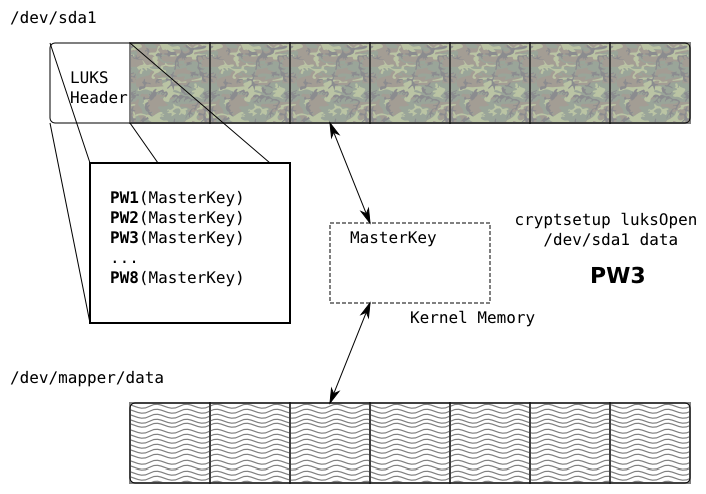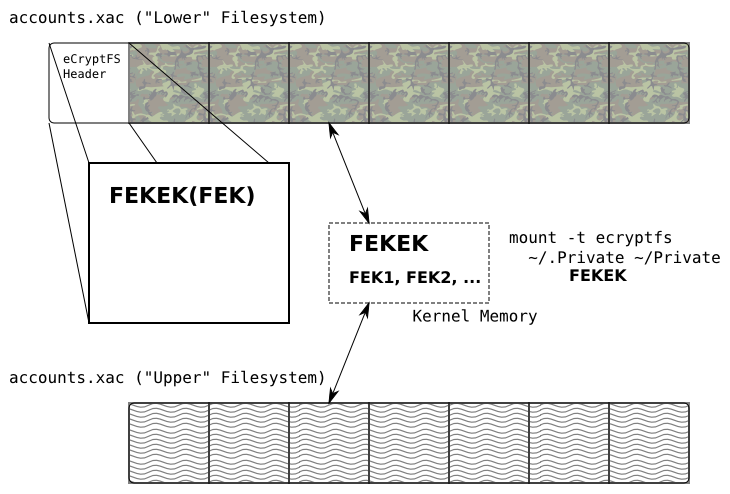
On Disk Encryption with Red Hat Enterprise Linux
Author: Bowe Strickland, Curriculum Manager Contact: bowe@redhat.com Copyright: Copyright © 2011, Red Hat, Inc. All rights reserved.
Contents
Block Device Encryption with dm-crypt and LUKS
Demonstration
Initialize device with random data: cat /dev/urandom
[root@station ~]# cat /dev/urandom > /dev/sda5 cat: write error: No space left on device
Format LUKS encryption layer: cryptsetup luksFormat
[root@station ~]# cryptsetup luksFormat /dev/sda5 WARNING! ======== This will overwrite data on /dev/sda5 irrevocably. Are you sure? (Type uppercase yes): YES Enter LUKS passphrase: shazbot Verify passphrase: shazbot
Open LUKS encryption layer: cryptsetup
[root@station ~]# cryptsetup luksOpen /dev/sda5 home_plaintext Enter passphrase for /dev/sda5: shazbot # for the curious [root@station ~]# ls -l /dev/mapper/ total 0 crw-rw----. 1 root root 10, 58 May 4 12:12 control lrwxrwxrwx. 1 root root 7 May 4 12:40 home_plaintext -> ../dm-0 # for the more curious [root@station ~]# dmsetup table home_plaintext: 0 1044480 crypt aes-cbc-essiv:sha256 000...000 0 252:5 4096
Format the filesystem: mkfs
[root@station ~]# mkfs.ext4 /dev/mapper/home_plaintext mke2fs 1.41.12 (17-May-2010) ... This filesystem will be automatically checked every 36 mounts or 180 days, whichever comes first. Use tune2fs -c or -i to override.
Mount the filesystem: mount
[root@station ~]# grep home /etc/fstab /dev/mapper/home_paintext /home ext4 defaults 0 0 [root@station ~]# mount -a [root@station ~]# df -h Filesystem Size Used Avail Use% Mounted on /dev/sda2 4.0G 1.4G 2.4G 37% / tmpfs 246M 0 246M 0% /dev/shm /dev/sda1 248M 30M 206M 13% /boot /dev/mapper/home_plaintext 494M 11M 459M 3% /homeRegister the encrypted drive: /etc/crypttab
[root@station ~]# man crypttab [root@station ~]# grep home /etc/crypttab home_plaintext /dev/vda5
Reboot and confirm
ecrypt-fs
Demonstration
Ensure the software is installed: yum
[root@station ~]# yum install -y ecryptfs-utils gettext Loaded plugins: refresh-packagekit, rhnplugin ... Installed: ecryptfs-utils.x86_64 0:82-6.el6 gettext.x86_64 0:0.17-16.el6 Dependency Installed: cvs.x86_64 0:1.11.23-11.el6 keyutils.x86_64 0:1.4-1.el6 libgomp.x86_64 0:4.4.4-13.el6 trousers.x86_64 0:0.3.4-4.el6 Complete!
Create a lower and upper directory: ~/.Private, ~/Private
[root@station ~]$ mkdir -m 700 ~/.Private [root@station ~]$ mkdir -m 500 ~/Private
Mount the upper directory for the first time: mount -t ecryptfs
[root@station ~]$ mount -t ecryptfs .Private Private Select key type to use for newly created files: 1) openssl 2) passphrase 3) tspi Selection: 2 Passphrase: Select cipher: 1) aes: blocksize = 16; min keysize = 16; max keysize = 32 (not loaded) 2) blowfish: blocksize = 16; min keysize = 16; max keysize = 56 (not loaded) 3) des3_ede: blocksize = 8; min keysize = 24; max keysize = 24 (not loaded) 4) cast6: blocksize = 16; min keysize = 16; max keysize = 32 (not loaded) 5) cast5: blocksize = 8; min keysize = 5; max keysize = 16 (not loaded) Selection [aes]: Select key bytes: 1) 16 2) 32 3) 24 Selection [16]: Enable plaintext passthrough (y/n) [n]: Enable filename encryption (y/n) [n]: Attempting to mount with the following options: ecryptfs_unlink_sigs ecryptfs_key_bytes=16 ecryptfs_cipher=aes ecryptfs_sig=be9b09a528a8651c WARNING: Based on the contents of [/root/.ecryptfs/sig-cache.txt], it looks like you have never mounted with this key before. This could mean that you have typed your passphrase wrong. Would you like to proceed with the mount (yes/no)? : yes Would you like to append sig [be9b09a528a8651c] to [/root/.ecryptfs/sig-cache.txt] in order to avoid this warning in the future (yes/no)? : yes Successfully appended new sig to user sig cache file Mounted eCryptfs
Try it out:
[root@station ~]$ cal 1752 > ~/Private/weird_year.txt [root@station ~]$ cat ~/Private/weird_year.txt 1752 January February March Su Mo Tu We Th Fr Sa Su Mo Tu We Th Fr Sa Su Mo Tu We Th Fr Sa 1 2 3 4 1 1 2 3 4 5 6 7 5 6 7 8 9 10 11 2 3 4 5 6 7 8 8 9 10 11 12 13 14 ... 31 July August September Su Mo Tu We Th Fr Sa Su Mo Tu We Th Fr Sa Su Mo Tu We Th Fr Sa 1 2 3 4 1 1 2 14 15 16 5 6 7 8 9 10 11 2 3 4 5 6 7 8 17 18 19 20 21 22 23 12 13 14 15 16 17 18 9 10 11 12 13 14 15 24 25 26 27 28 29 30 19 20 21 22 23 24 25 16 17 18 19 20 21 22 26 27 28 29 30 31 23 24 25 26 27 28 29 30 31 .... [root@station ~]$ cat ~/.Private/weird_year.txt (... binary ciphertext ...)Unmount the upper filesystem
[root@station ~]# umount ~/Private
Access the filesystem again:
[root@station ~]# mount -t ecryptfs .Private Private Select key type to use for newly created files: 1) tspi 2) passphrase 3) openssl Selection: 2 Passphrase: Select cipher: 1) aes: blocksize = 16; min keysize = 16; max keysize = 32 (not loaded) 2) blowfish: blocksize = 16; min keysize = 16; max keysize = 56 (not loaded) 3) des3_ede: blocksize = 8; min keysize = 24; max keysize = 24 (not loaded) 4) cast6: blocksize = 16; min keysize = 16; max keysize = 32 (not loaded) 5) cast5: blocksize = 8; min keysize = 5; max keysize = 16 (not loaded) Selection [aes]: Select key bytes: 1) 16 2) 32 3) 24 Selection [16]: Enable plaintext passthrough (y/n) [n]: Enable filename encryption (y/n) [n]: Attempting to mount with the following options: ecryptfs_unlink_sigs ecryptfs_key_bytes=16 ecryptfs_cipher=aes ecryptfs_sig=0b1460fdbe4ce020 Mounted eCryptfs
Procedure
Ensure the user is a member of the group ecryptfs
[root@station ~]# usermod -G ecryptfs prince [root@station ~]# id prince uid=501(prince) gid=501(prince) groups=501(prince),489(ecryptfs)
Setup the private directory: ecryptfs-setup-private
[prince@station ~]$ ecryptfs-setup-private Enter your login passphrase: Enter your mount passphrase [leave blank to generate one]: ************************************************************************ YOU SHOULD RECORD YOUR MOUNT PASSPHRASE AND STORE IT IN A SAFE LOCATION. ecryptfs-unwrap-passphrase ~/.ecryptfs/wrapped-passphrase THIS WILL BE REQUIRED IF YOU NEED TO RECOVER YOUR DATA AT A LATER TIME. ************************************************************************ Done configuring. Testing mount/write/umount/read... Testing succeeded. Logout, and log back in to begin using your encrypted directory.
Examine the unmounted directory:
[prince@station ~]$ ls Private/ Access-Your-Private-Data.desktop README.txt [prince@station ~]$ cat Private/README.txt THIS DIRECTORY HAS BEEN UNMOUNTED TO PROTECT YOUR DATA. From the graphical desktop, click on: "Access Your Private Data" or From the command line, run: ecryptfs-mount-private
Mount the private directory: ecryptfs-mount-private
[prince@station ~]$ ecryptfs-mount-private Enter your login passphrase: Inserted auth tok with sig [cfa25b7ea56bf148] into the user session keyring
Use the upper directory:
[prince@station ~]$ ls Private/ [prince@station ~]$ cal > Private/calendar.txt [prince@station ~]$ head -3 Private/calendar.txt May 2011 Su Mo Tu We Th Fr Sa 1 2 3 4 5 6 7Examine the lower directory:
[prince@station ~]$ ls ~/.Private/ ECRYPTFS_FNEK_ENCRYPTED.FWal9veJf-KsekRSh8hEpQYK4fIgutwbjEoEBPttMaVSU5yrvxCv vZs0uU-- [prince@station ~]$ head -3 ~/.Private/ECRYPTFS_FNEK_ENCRYPTED.FWal9veJf-Kse kRSh8hEpQYK4fIgutwbjEoEBPttMaVSU5yrvxCvvZs0uU-- (... encrypted ciphertext ...)
When finished, unmount the private directory: ecryptfs-umount-private
[prince@station ~]$ ecryptfs-umount-private [prince@station ~]$ ls Private/ Access-Your-Private-Data.desktop README.txt
Labs
Encrypting the /home partition
Login into your station as root.
Preserve the contents of you /home partition by archiving to the /tmp directory:
[root@station ~]# rsync -av /home /tmp
Unmount the existing /home partition:
[root@station ~]# umount /home
In practice, you should initialize the device with random data. For the purposes of this lab, this time consuming step can be skipped:
# you may omit this step [root@station ~]# cat /dev/urandom > /dev/vol0/home
Initialize the LUKS formatting on the block device. When prompted, provide a password of your choosing, but do not forget the password:
[root@station ~]# cryptsetup luksFormat /dev/vol0/home
Open the initialized device, using home_plaintext as the name of the manufactured plaintext interface:
[root@station ~]# cryptsetup luksOpen /dev/vol0/home home_plaintext
Create an ext4 filesystem:
[root@station ~]# mkfs.ext4 /dev/mapper/home_plaintext
Create a /etc/fstab entry which mounts the /dev/mapper/home_plaintext interface to the /home mountpoint:
[root@station ~]# grep home /etc/fstab /dev/mapper/home_paintext /home ext4 defaults 0 0
Mount the partition, using the /etc/fstab entry to ensure correctness:
[root@station ~]# mount -a
Restore the original data to the /home partition:
[root@station ~]# rsync -av /tmp/home/ /home
In order to automatically open the encrypted device on bootup, add the following entry to the /etc/crypttab file:
[root@station ~]# grep home /etc/crypttab home_plaintext /dev/vol0/home
Reboot your station to confirm a clean reboot.
Creating an encrypted ~/Private directory.
Login into your station as the user student.
Open a terminal, and su to the root account:
[student@station ~]$ su - [root@station ~]#
Install the ecryptfs-utils and gettext packages:
[root@station ~]# yum install -y ecryptfs-utils gettext
Add the user student to the ecryptfs group, and exit:
[root@station ~]# usermod -G ecryptfs student [root@station ~]# id student [root@station ~]# exit [student@station ~]$
As the user student, run the command ecryptfs-setup-private. Authenticate with your login password, and accept defaults for all remaining questions:
[student@station ~]$ ecryptfs-setup-private
- The newly created ~/Private directory can be mounted with
ecryptfs-mount-private and unmounted with ecryptfs-umount-private. Copy file into the mounted directory, and observe their ciphertext equivalents in ~/.Private.
Preserve the contents of the /home partition by archiving to the /tmp directory:
[root@station ~]# rsync -av /home /tmp
Unmount the existing /home partition:
[root@station ~]# umount /home
In practice, you should initialize the device with random data. For the purposes of this lab, this time consuming step can be skipped:
# you may omit this step [root@station ~]# cat /dev/urandom > /dev/vol0/home
Initialize the LUKS formatting on the block device. When prompted, provide a password of your choosing, but do not forget the password:
[root@station ~]# cryptsetup luksFormat /dev/vol0/home
Open the initialized device, using home_plaintext as the name of the manufactured plaintext interface:
[root@station ~]# cryptsetup luksOpen /dev/vol0/home home_plaintext
Create an ext4 filesystem:
[root@station ~]# mkfs.ext4 /dev/mapper/home_plaintext
Create a /etc/fstab entry which mounts the /dev/mapper/home_plaintext interface to the /home mountpoint:
[root@station ~]# grep home /etc/fstab /dev/mapper/home_paintext /home ext4 defaults 0 0
Mount the partition, using the /etc/fstab entry to ensure correctness:
[root@station ~]# mount -a
Restore the original data to the /home partition:
[root@station ~]# rsync -av /tmp/home/ /home
In order to automatically open the encrypted device on bootup, add the following entry to the /etc/crypttab file:
[root@station ~]# grep home /etc/crypttab home_plaintext /dev/vol0/home
Reboot your station to confirm a clean reboot.

